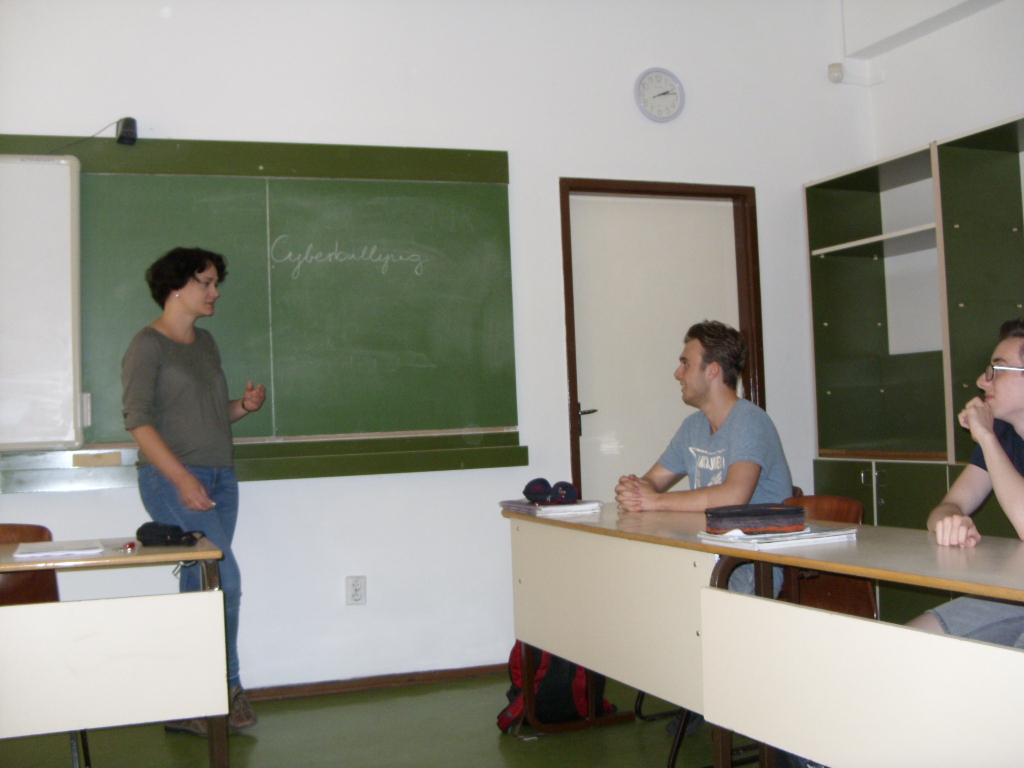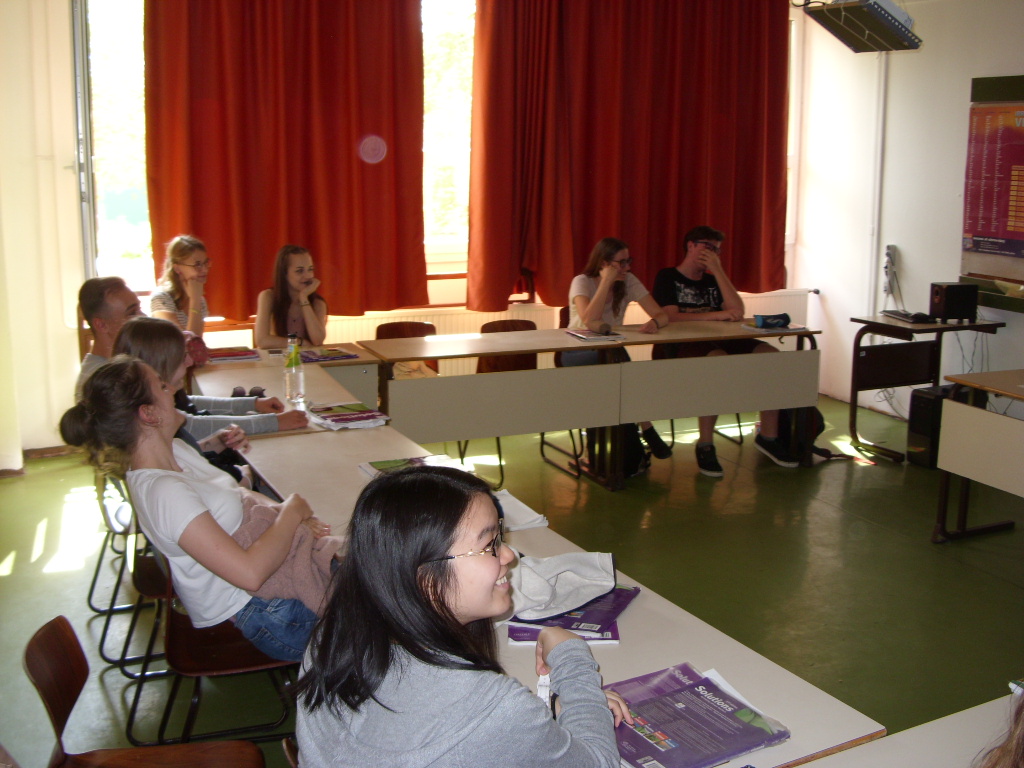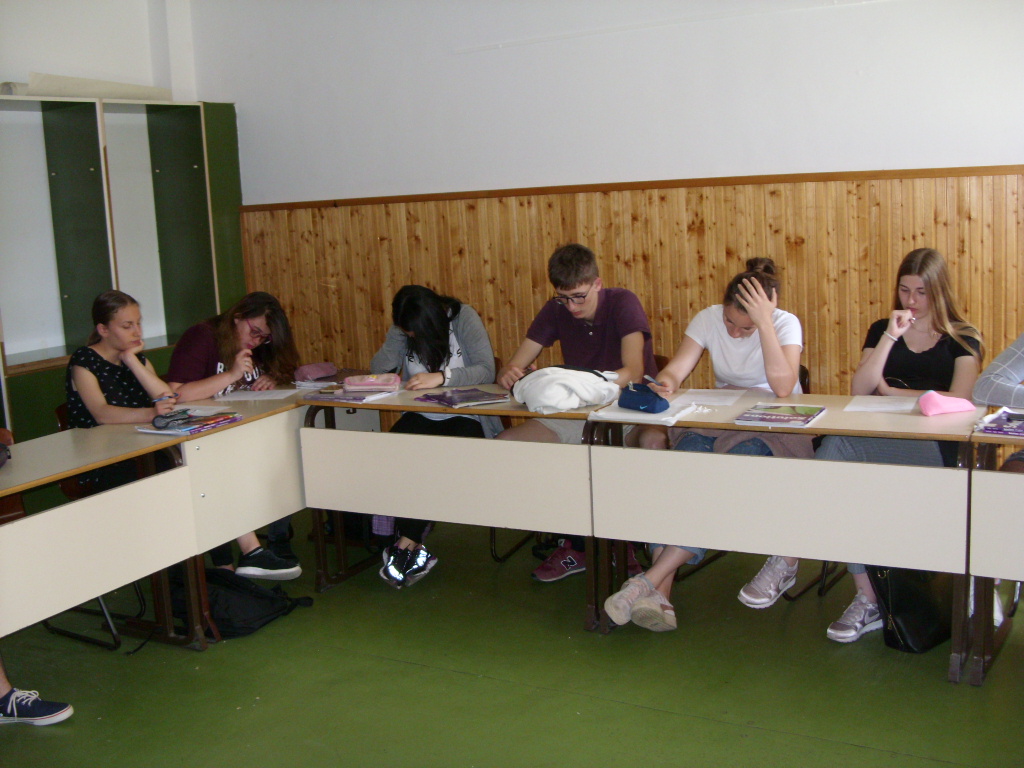Cyberbullying (by Kackstetter Mária)
Cyberbullying - lesson in connection with nonviolence /2x 45 minutes/
Lesson objectives and outcomes: Students will be able to...
• define cyberbullying.
• list the three key characteristics of cyberbullying.
• list appropriate responses to cyberbullying.
• create a survey
https://docs.google.com/document/d/1JmZbxEiWsjq5bleR961wI3y2M0gkNM5O_xu8c7Y4hXs/edit?ts=5ae8176e



Lesson plan:
https://docs.google.com/document/d/1JmZbxEiWsjq5bleR961wI3y2M0gkNM5O_xu8c7Y4hXs/edit#
- Lesson time: 2x 45 minutes
- This lesson includes 3 activities.
Lesson Objectives and Outcomes: Students will be able to...
- define cyberbullying.
- list the three key characteristics of cyberbullying.
- list appropriate responses to cyberbullying.
- create a survey.
Begin the lesson with a reflection exercise to stimulate students’ awareness. Ask them to think about situations in which they felt harassed, bullied, or hurt by the actions or words of another they have personally experienced.
Next write ‘cyberbullying’ on the board and ask students tell words/expressions/feelings which come to their mind in connection with it.
Provide examples (or ask students to share stories) of bullying. (e.g.: Tom and Sarah created a website that ranks all the kids in their grade from the most to the least popular. They update the standings every day. e.g.: Lynn receives e-mails and posts on her social media page from the members of a group at school every day. The messages accuse Lynn of things that she knows she didn’t do.) Ask students how they would respond to situations. Discuss the suggestions and the best options.
Activity 1:
Students will get a multiple choice activity to identifying cyberbullying behaviour, roles and responsibilities. (worksheet 1) (answers: d, d, b, c, d, d, a, d)
Activity 2:
Students will get some background information about cyberbullying. Students have to define key vocabulary words. (worksheet 2) Explain to students that cyberbullying, like all bullying, has three key characteristics. If one of the characteristics is missing, then the conduct cannot be defined as cyberbullying. Write on the board: POWER, INTENT, and REPETITION.
Activity 3:
Have students work in small groups. Distribute the handout Survey Generator to students. Go over the steps and tips for how to create, and then conduct, an effective survey. Allow each group 15-20 minutes to design their own surveys, including 7 to 10 unique questions. Have groups share their questions and invite others to provide suggestions for how to improve or revise their surveys. Students will have a week to distribute their surveys and receive responses. (handout)
Key Vocabulary:
- cyberbullying: using technology to hurt or threaten someone.
- target: a person a bully hurts.
- bullying: aggressive behaviour to harm and humiliate someone deliberately and repeatedly.
- bystander: someone who sees something that is wrong but simply “stands by” and doesn’t do anything to support someone or speak up. A bystander will witness a situation/ behaviour but take no action.
- upstander: someone who not only recognizes when something is wrong, but as a result, stands up for his/her beliefs by taking action. An upstander will help/support whomever who is being hurt, or will speak up to correct the situation/make it right.
Worksheet 2
Background
Cyberbullying is the use of online technology, such as computers and mobile phones, to bully a person or group. Bullying is repeated behaviour by an individual or group with the intent to harm another person or group.
Young people can cyberbully each other in many ways. Sending hurtful texts or abusive emails, excluding individuals from online conversations, imitating someone online, posting inappropriate images and trolling are some of the ways people can cyberbully each other.
Cyberbullying can happen to anyone and typically involves a person who perpetrates the bullying behaviour against a target – the person being bullied. In some instances there may also be bystanders involved – people who witness someone being cyberbullied. A positive bystander is someone who offers support to the target and does not ignore or participate in the bullying behaviour, such as forwarding on humiliating images.
Cyberbullying is serious because it can be relentless and occur 24 hours a day, extending well beyond school grounds and into ‘safe’ spaces, such as in homes. Its effects can be damaging, making a person feel isolated, friendless, miserable and insecure.
It is important to empower younger internet users with the knowledge of how to act responsibly and with resilience online, and equip them with the tools to know how to deal with cyberbullying behaviour. It is also crucial to demonstrate how others can be affected by their interactions online and what language and actions are considered appropriate in the online environment.
Experts agree that bullying conduct has three key characteristics: power, intent, and repetition. The person bullying has more power than his or her target. He or she decides to hurt the target through his or her words or actions. The bullying conduct happens more than once.
Key vocabulary:
- cyberbullying:
- target:
- bullying:
- bystander:
- upstander:
Handout In this activity, you will create a survey of your own to collect information from people within your community.First ask yourself the following questions, then follow the tips to create your customized survey.
1. Who do you want to ask? Friends, classmates, teachers, parents, strangers?
2. What do you want to know more about? Be specific!
3. How do you want to tell people about the survey?
4. How will you ensure that those who participate in your survey will remain anonymous?
TIPS FOR A GOOD SURVEY:
- Keep the survey short (7 to 10 questions). Ask only questions that will provide you with the information that you need.
- Use casual language. Make it easy for everyone to understand the questions.
- Use a variety of question formats, but try to use multiple choice questions whenever possible.
Question formats:
Multiple Choice:
- with 3 to 6 options
- True or False; Yes or No
- Ranking Scale: Strongly Agree – Agree – Neutral – Disagree – Strongly Disagree
- Include information about who is taking the survey, to help categorize your findings.
(Note: Do not ask participants to include their name.)
For example:
- Are you: • Male • Female
- If you are a student, what grade are you in? • Grade 4 • Grade 5
- Describe yourself: • Teacher • Student • Staff • Parent
Worksheet 3
1. Cyberbullying is:
a. Using online technology to deliberately and repeatedly bully someone
b. Using online technology to make someone feel insecure and miserable.
c. Using online technology to make someone feel isolated and friendless.
d. All of the above.
2. The types of people who are cyberbullied are:
a. Trouble makers.
b. Popular and outgoing.
c. Shy and sensitive.
d. Anyone can be cyberbullied.
3. Cyberbullying is considered to be:
a. Not that serious – everyone gets bullied at school.
b. Very serious – it makes people feel unsafe at home as well as at school.
c. Fairly serious – but only because there is always evidence.
d. Who wants to be serious? I only go online for fun.
4. If I am being bullied on a social networking site I can:
a. Ask my friends to help me retaliate.
b. Try to forget its happening.
c. Use that site’s report function.
d. Never go online again.
5. A cyberbully is usually:
a. Big, mean, and obviously a bully.
b. Sneaky, anonymous, and will never be found out.
c. A particular kind of extremely bad person.
d. Anyone, including my friends or I, if we aren’t careful about how we treat others online.
6. Ways to prevent cyberbullying include:
a. Not replying to hurtful messages or posts.
b. Using the block, report and privacy settings on the sites where cyberbullying behaviour is occurring.
c. Collecting evidence of cyberbullying behaviour, such as nasty texts and reporting it to a trusted adult, like a parent or teacher.
d. All of the above.
7. Talking to a trusted adult about cyberbullying is:
a. A good idea. There’s no reason to suffer alone.
b. Not worth it because it will make the person who is doing the bullying angrier.
c. Never a good idea, it can only make things worse.
d. A waste of time because they don’t understand.
8. In a cyberbullying situation, a positive bystander is a person who:
a. Does not ignore what they see happening to someone else.
b. Asks the person who is the target of the bullying behaviour if they are OK.
c. Reports the behaviour to someone who can help, like a trusted adult.
d. All of the above.